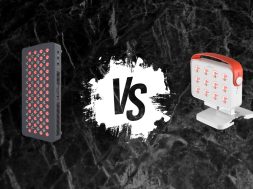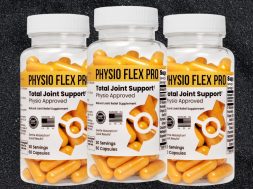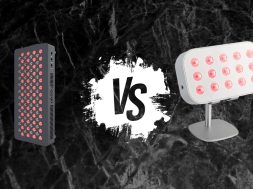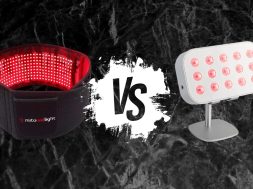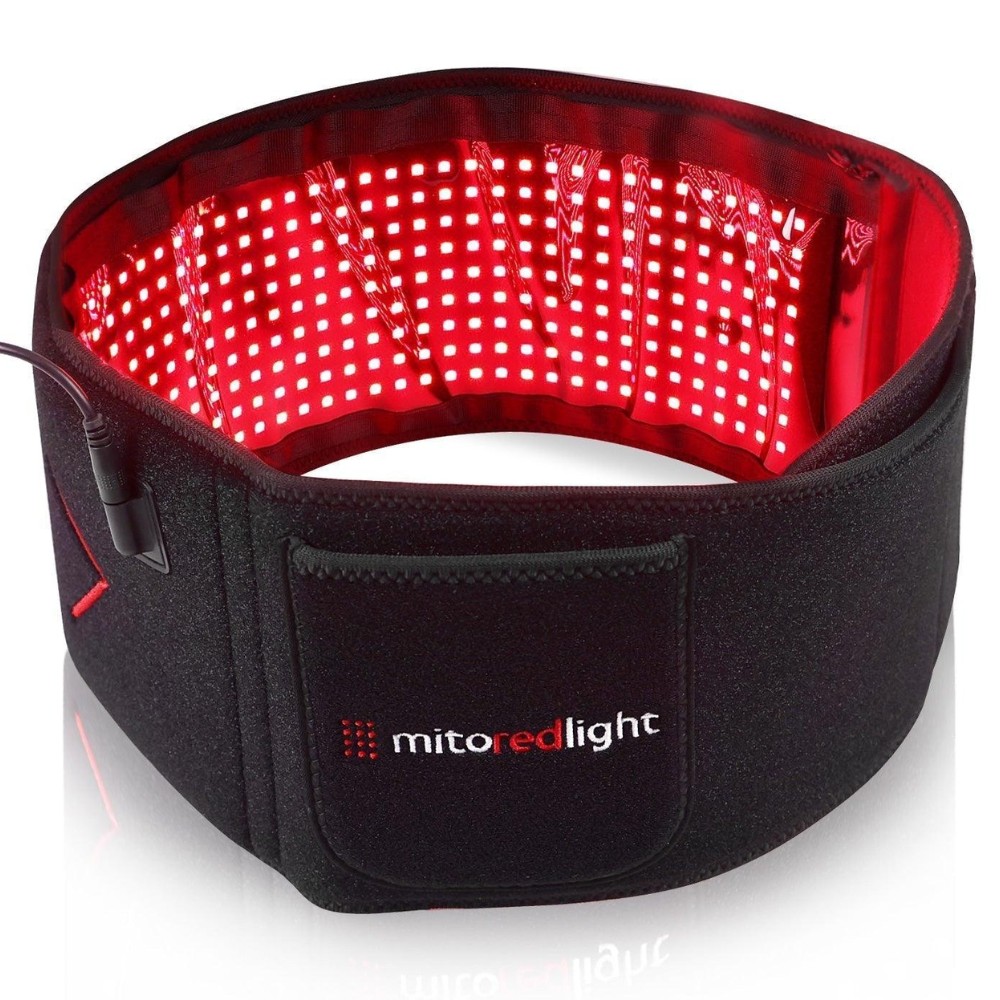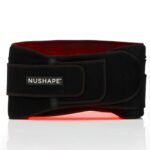
If you’re anything like me, training hard, chasing your kids around, and trying to stay ahead of joint pain, then you know how frustrating knee issues can be. Whether it’s the aftermath of squats, grappling sessions, or just years of wear and tear, knee pain has a way of slowing everything down.
That’s where red light therapy comes in.
Over the past year, I’ve tested a range of red light devices on myself and with the athletes I coach, trying to find what works. Some of these tools have become part of my daily recovery routine. Others? Not so much.
I’ll walk you through the best red light therapy devices specifically for knee pain, from high-powered laser/LED hybrids to budget-friendly wearable belts.
- Best Red Light Therapy Devices for Knee Pain: Kineon MOVE+ Pro
- Best Red Light Therapy Pad for Knee Pain: Novaalab Deep Healing Pad
- Best Budget Red Light Therapy Device for Knee Pain: Hooga Red Light Therapy Belt
- Best Red Light Therapy Belt for Knee Pain: MitoQUAD Wavelength Belt
- Best Red Light Therapy Panel for Knee Pain: Lumaflex
- Best Red Light Therapy Device for Knee Pain On Amazon: Lifepro AllevaRed Light Therapy Belt
- Best Small Joint Red Light Therapy Devices for Knee Pain: Nushape Mini Red Light Therapy Device
Best Red Light Therapy Devices for Knee Pain
Kineon MOVE+ Pro
The Kineon MOVE+ Pro is the most effective red light therapy device I’ve used for knee pain, both in terms of performance and convenience.
What makes the MOVE+ Pro unique is its combination of 660nm red light and 808nm infrared lasers, allowing for both surface-level and deep tissue treatment.
Unlike most LED-only devices, this one uses laser light for more targeted penetration, and that makes a difference when you’re trying to reach deeper joint structures.
It’s modular, so you can adjust the three light pods to fit around your knee, ankle, or even elbow. For me, wrapping it snugly around my knee post-training has become a ritual.
After just a few 15-minute sessions, I noticed less stiffness and better joint mobility. After two weeks of daily use, it cut down my post-grappling inflammation dramatically.
The hands-free design is another huge win. I can strap it on and keep working, cooking, or even play with my kids, no need to sit still like with panel systems. Battery life is impressive too; I’m usually good for a full week before needing a recharge.
That said, the $499 price point is a hurdle for some. But if you’re someone who’s dropped cash on therapy sessions, massage, or compression gear, this device pays for itself quickly.
One downside? The initial setup has a bit of a learning curve in finding the best light placement, especially on smaller joints. But once you figure it out, it becomes second nature.
For chronic joint pain or consistent knee stress from training, this is the one I recommend without hesitation. You can read my experience in my Kineon review.
Pros
- Dual-wavelength (660nm red, 808nm infrared) for deep tissue penetration
- Modular, hands-free design for targeted therapy
- Highly portable and easy to use during daily activities
- Excellent for chronic joint pain and inflammation
- Good battery life (up to 24 sessions per charge)
Cons
- Expensive ($499)
- Learning curve for optimal placement on smaller joints
- Limited coverage area for larger muscle groups
- Requires multiple sessions for extended treatment
Kineon MOVE+ Pro
Kineon MOVE+ Pro
Powerful red light therapy device designed be applied without having to sit in front of a large light panel.
CHECK CURRENT DEALSBest Red Light Therapy Pad for Knee Pain
Novaalab Deep Healing Pad
I’ve used it consistently over the span of a month, and while it doesn’t match the depth of something like the Kineon MOVE+ Pro, it holds its own for general soreness and joint stiffness.
The pad uses 660nm red light and 850nm near-infrared light, which are two of the most studied wavelengths for joint recovery and inflammation. The design is straightforward — it’s a flexible silicone pad that wraps around the knee and fastens with Velcro straps.
The coverage is generous, and the pad molds well to the knee joint, giving even exposure without fussing with positioning too much.
One thing I appreciated is how easy it is to use. You plug it in, strap it on, and choose between steady or pulsed light with adjustable frequency settings.
The pulsed modes sound impressive on paper, and they offer 1 to 999Hz frequency options, but in practice, I mostly stuck to the steady light mode. It felt the most effective, especially after heavy leg days or when my knees were achy after squats.
The downsides? It’s corded, which limits mobility. I found myself wishing for a wireless option more than once, especially during longer sessions when I wanted to move around. Also, the controller feels a bit flimsy, and the Velcro straps might wear out with frequent use, though mine held up okay during testing.
At around $300–$400, depending on sales, it sits comfortably in the mid-tier of red light devices. If you’re someone dealing with occasional knee pain or soreness, and you want something more versatile than a belt or localized laser system, this pad is a good bet.
I wouldn’t call it elite, but it’s dependable, easy to use, and delivers consistent results, making it a great option for recreational athletes or anyone with a recovery routine at home. You can read my experience in my Novaalab review.
Pros
- Dual wavelengths (660nm red, 850nm near-infrared)
- Flexible design, wraps well around knees
- Easy to use, minimal setup
- Affordable in the mid-range ($300–$400)
Cons
- Corded design limits mobility
- Controller feels flimsy
- Velcro straps may wear out with frequent use
- No intensity adjustment options
Novaalab Deep Healing Pad
Novaalab Deep Healing Pad
Powerful red light therapy device designed be applied without having to sit in front of a large light panel.
CHECK CURRENT DEALSBest Budget Red Light Therapy Device for Knee Pain
Hooga Red Light Therapy Belt
Priced at around $299, it’s significantly cheaper than some of the higher-end devices out there, but it doesn’t feel like a compromise if you’re looking for relief and recovery in a simple package.
The Hooga belt uses the standard but clinically supported 660nm red and 850nm near-infrared wavelengths and it’s battery-powered, which makes it super portable. I’ve worn it while working, cooking, or hanging out with my kids, which is a big plus if you’re trying to fit recovery into a packed schedule.
Strapping it around my knee after tough grappling sessions or squat-heavy days quickly became routine. The gentle warmth it produces feels soothing, and with 5–6 weekly sessions, I saw noticeable reductions in soreness and stiffness.
It’s not as deep-penetrating or precise as laser-based options like the Kineon, but for general post-workout recovery or occasional flare-ups, it absolutely gets the job done.
There are limitations, of course. There’s no way to adjust intensity, and the belt only runs one 20-minute auto-shutoff cycle. It’s simple, but if you want custom settings or app control, this isn’t the device for you.
Also, the Velcro straps are a weak point; after a few weeks of daily use, they started showing signs of wear. And if you want to treat multiple areas, you’ll need to manually move the belt around, since the coverage is fairly small.
Still, for the price, portability, and consistent results, the Hooga belt punches above its weight. If you’re just starting with red light therapy or want an effective device without shelling out $500+, this is a budget-friendly workhorse that delivers real value.
You can read my experience in my Hooga review.
Pros
- Portable, battery-powered, easy to use on-the-go
- Dual wavelengths (660nm red, 850nm near-infrared)
- Affordable ($299)
- Lightweight and comfortable
- Simple operation (one-button design)
Cons
- No intensity adjustments
- Velcro straps may wear out over time
- Small coverage area, requires repositioning
- No app or tracking features
Hooga Red Light Therapy Belt
Hooga Red Light Therapy Belt
Powerful red light therapy device designed be applied without having to sit in front of a large light panel.
CHECK CURRENT DEALSBest Red Light Therapy Belt for Knee Pain
MitoQUAD Wavelength Belt
I tested it primarily for heavy-santch day knee stiffness and recovery from grappling-induced strain, and it definitely made an impact.
Unlike most devices that rely on just two wavelengths, the MitoQUAD uses four: 630nm, 660nm, 810nm, and 850nm. This spectrum covers both surface-level inflammation and deeper tissue recovery.
The LED density is impressive too, loaded with 1,215 LED chips, using what they call “TriChip technology.” That sounds like marketing fluff, but in practice, it translates to strong, even light distribution and a noticeable warming effect that kicks in within a few minutes of use.
I mainly used it on my lower back and knees, and while the belt is optimized for the core region, it wraps around knees fairly well, though not as precisely as modular systems like the Kineon. The five intensity levels give you some customization, which I appreciated, especially when using it on sensitive areas.
That said, the MitoQUAD is corded, which limits portability. You’re tethered to a wall, so forget about walking around during your session.
And while the fixed shape works great on the midsection, it’s a bit less adaptable for smaller joints like the knees unless you’re willing to get creative with positioning. Still, the therapeutic warmth and depth of treatment it provides made a noticeable difference in my recovery, especially on heavy lifting weeks.
Retailing for around $350, it’s not a cheap option, but it’s not overpriced for the performance and LED density. If you want a belt-style unit with more muscle than the budget-friendly Hooga, and don’t mind the cord, the MitoQUAD is a strong pick.
You can read my experience in my Mito Red Light Therapy review.
Pros
- Four wavelengths (630nm, 660nm, 810nm, 850nm) for comprehensive recovery
- High LED density (1,215 chips) for effective treatment
- Five intensity levels for customized therapy
- Hands-free design, allows mobility during use
Cons
- Corded, limiting mobility
- Fixed width, less effective for smaller joints
- No wireless or battery-powered option
- Priced at $350, not as cost-effective as some alternatives
MitoQUAD Wavelength Belt
MitoQUAD Wavelength Belt
Powerful red light therapy device designed be applied without having to sit in front of a large light panel.
CHECK CURRENT DEALSBest Red Light Therapy Panel for Knee Pain
Lumaflex

The Lumaflex Body Pro is one of the pricier options on the market, coming in at $689, and it definitely looks and feels like a premium device.
But after using it extensively on my knees, lower back, and shoulders over the span of a month, I’d say it’s a solid product, though whether it’s worth the high price depends on your priorities.
First off, the build quality is excellent. The panel is flexible and contours well around joints like the knee, and the materials are clearly high-end. It’s also fully waterproof, with an IP67 rating, which is nice if you’re using it right after a sweaty session.
It uses the typical 630nm and 850nm dual wavelengths, both of which are well-supported by research for tissue healing and inflammation reduction.
In terms of actual performance, the Body Pro does what it promises. I noticed a modest reduction in soreness and stiffness after lower body training. When I used it right after heavy squats or grappling rounds, my knees felt a bit more mobile and less inflamed the next day.
However, and this is key, the results weren’t significantly better than what I’ve experienced with lower-priced options, such as the Kineon or even the Novaalab.
Where it really shines is ease of use and design. You strap it on, hit a button, and it auto-runs a 10-minute session. The app control adds some nice polish, letting you adjust intensity and track usage, though it’s not essential.
Battery life is decent at about 6–8 sessions per charge, and the device remembers your last setting, which is a small but helpful touch.
That said, the coverage area is limited for a panel-style device. You’ll still need to reposition it if you’re targeting more than one joint. And while the performance is good, it’s hard to justify the steep price tag when other options provide similar or better results for less.
In short, if you want a sleek, medical-grade, waterproof panel with some smart features and you’re okay paying for premium build quality, the Lumaflex Body Pro is a good fit. But if you’re looking for maximum value per dollar or deeper tissue treatment, there are better picks.
My Lumaflex review goes into detail about my experience.
Pros
- Premium build quality, fully waterproof (IP67 rating)
- Dual wavelengths (630nm red, 850nm near-infrared)
- FDA-cleared medical device
- App control for adjusting settings and tracking use
- Flexible design for various body areas
Cons
- High price ($689) for the performance offered
- Limited coverage area for larger muscle groups
- Battery life is lower than expected (6–8 sessions per charge)
- Velcro straps could be sturdier for the price
Best Red Light Therapy Device for Knee Pain On Amazon
Lifepro AllevaRed Light Therapy Belt
It’s one of the more accessible devices out there, and while it’s not the most advanced option, it gets the job done for most users dealing with mild to moderate knee pain.
The AllevaRed Belt uses 660nm red light and 850nm near-infrared light, which is the standard combo for reducing inflammation and promoting cellular repair.
These are the same wavelengths used in more expensive units like the Kineon or MitoQUAD, so you’re not sacrificing the therapeutic range. The belt delivers solid coverage and wraps easily around joints like the knees, making it ideal for anyone targeting a specific pain point.
What surprised me during testing was how comfortable and lightweight it is. The belt is soft, flexible, and doesn’t overheat, even during full 20-minute sessions.
You can move around during treatment (it’s cordless and rechargeable), which is a big plus if you don’t have time to sit still or want to multitask while recovering.
Where the AllevaRed falls short is customization. It offers no intensity adjustments, and there’s no app or data tracking. It’s a basic strap-on-and-go design, which, to be fair, works for most people who just want relief without overcomplicating things. The battery life is decent (you’ll get 4–6 sessions per charge), and recharging via USB is quick.
Priced under $200 depending on current discounts, it’s one of the most affordable red light therapy belts with real functionality. User reviews are generally positive, especially for joint pain and post-exercise recovery, though some mention that the Velcro wears out over time, similar to other belts in this range.
If you want fast relief from knee pain, quick Amazon shipping, and decent value, the Lifepro AllevaRed Belt is a convenient entry-level device.
Pros
- Affordable ($150–$200)
- Portable, battery-powered, easy to use
- Dual wavelengths (660nm red, 850nm near-infrared)
- Compact design, great for targeting localized pain
Cons
- No intensity adjustments
- Velcro straps can wear out quickly
- Limited coverage area, requires repositioning
- No app integration or advanced features
Lifepro AllevaRed Light Therapy Belt
Lifepro AllevaRed Light Therapy Belt
Powerful red light therapy device designed be applied without having to sit in front of a large light panel.
CHECK CURRENT DEALSBest Small Joint Red Light Therapy Devices for Knee Pain
Nushape Mini Red Light Therapy Device
While it doesn’t have the power or range of larger panels or belts, it’s designed for precision, and that’s exactly what makes it effective for knee pain, especially in localized problem spots like the patella or IT band region.
The Nushape Mini uses a dual-wavelength system (typically 660nm red and 850nm near-infrared), which is standard in most quality red light therapy products.
What sets this one apart is its handheld, laser-focused design, which lets you hone in on very specific pain points without wasting light energy on surrounding areas.
If your knee issues are concentrated in one particular zone this device can give you relief without needing to wrap or strap anything around your leg.
From a usability standpoint, it’s incredibly lightweight and portable, ideal for people who want to use red light therapy while watching TV, working at a desk, or even during travel. It fits easily in a gym bag or drawer and charges via USB.
It’s not without trade-offs. The coverage area is very small, so if you’re dealing with widespread inflammation around the entire joint, you’ll need to move it around, and that takes time.
There’s no app integration or advanced controls, just a simple button and timer-based session (usually 10–15 minutes). And at around $349, it’s not exactly cheap for its size.
Still, if you’re dealing with targeted knee pain or want a device that works well on multiple smaller joints, the Nushape Mini is a smart choice. It’s efficient, well-built, and ideal for athletes or anyone who needs focused relief without bulk.
You can read my experience in my Nushape review.
Pros
- Compact and portable, easy to carry
- Dual wavelengths (660nm red, 850nm near-infrared)
- Targeted therapy for small joints (knees, wrists, elbows)
- Rechargeable, lightweight design
- Great for localized pain relief
Cons
- Very small coverage area, requires moving device for larger treatment
- No intensity control or app connectivity
- Higher price for its size ($349)
- Limited to specific joint treatment
Nushape Mini Red Light Therapy Device
Nushape Mini Red Light Therapy Device
Powerful red light therapy device designed be applied without having to sit in front of a large light panel.
CHECK CURRENT DEALSThe Science Behind Red Light Therapy For Knee Pain
The science behind red light therapy revolves around something called photobiomodulation (PBM) – a process I initially dismissed as marketing jargon until I dove into the research. When specific wavelengths of red and near-infrared light (typically 660nm and 850nm) penetrate your tissues, they trigger a cascade of cellular reactions that would make any biology textbook jealous.
How Light Becomes Medicine
Your cells have these tiny powerhouses called mitochondria that essentially run on light. When red light hits them, they produce more ATP – the cellular currency of energy. I watched a demonstration where researchers showed cells literally “lighting up” with increased activity under red light exposure. It’s like giving your knee cells a turbo boost.
The penetration depth matters enormously. Red light at 660nm reaches about 5-10mm into tissue, perfect for superficial inflammation. But near-infrared at 850nm? That penetrates 40-50mm deep, reaching the actual joint structures, causing my pain. This explained why some devices worked better than others – they weren’t all reaching the problem areas.
The Inflammation Connection
My orthopedic surgeon showed me thermal imaging of my inflamed knee before and after a month of red light therapy. The angry red and yellow patches had noticeably diminished. The science behind this involves nitric oxide release from cells, which improves blood flow and reduces the inflammatory cascade that keeps pain chronic.
| Biological Effect | Timeframe | What I Noticed |
|---|---|---|
| Increased ATP production | Immediate | Warmth and tingling sensation |
| Nitric oxide release | 5-10 minutes | Reduced stiffness |
| Enhanced circulation | 15-30 minutes | Less throbbing pain |
| Reduced inflammation | 2-4 weeks | Improved mobility |
| Tissue repair | 4-12 weeks | Lasting pain relief |
The Pain Pathway Interruption
Red light therapy actually interrupts pain signals. The therapy stimulates the release of endorphins – your body’s natural painkillers – while simultaneously reducing substance P, a neurotransmitter that amplifies pain sensations. I’ve heard a neurologist explain it’s like turning down the volume on pain while turning up the body’s healing response.
I tracked my pain levels religiously and noticed something interesting: the relief wasn’t just during treatment. The cumulative effect built over weeks, suggesting actual tissue repair rather than just symptom masking.
Studies show this happens through increased collagen production and improved cellular metabolism, basically, your knee starts rebuilding itself properly.
Why Some Treatments Fail
After researching extensively, I discovered why my initial attempts with cheap devices failed. The irradiance (power density) needs to reach at least 20-40 mW/cm² for therapeutic effects. Many consumer devices barely hit 10 mW/cm². It’s like trying to charge your phone with a AAA battery – technically delivering power, but nowhere near enough to matter.
The treatment time also follows a biphasic dose response, meaning too little does nothing, but too much can actually inhibit healing.
Most effective protocols deliver 4-6 Joules/cm² of energy. I learned to calculate this: irradiance × time = dose. My successful treatments typically lasted 10-20 minutes at proper power levels.
Benefits of Red Light Therapy for Knee Pain
Immediate Pain Relief Without Pills
One of the biggest advantages of red light therapy is that it provides drug-free pain relief, often within just a few sessions. Instead of masking symptoms with painkillers or NSAIDs, red light targets the root of the discomfort by calming overactive nerve endings and improving tissue repair.
For those dealing with nagging knee pain from training or aging, this means you can skip the meds and still get real relief.
Inflammation Reduction That Actually Lasts
Chronic inflammation is a major culprit in long-term knee pain, especially in conditions like arthritis or overuse injuries. Red and near-infrared wavelengths have been shown to modulate the body’s inflammatory response, reducing swelling and stiffness at the joint level. Unlike ice packs or creams, the effects build over time, meaning you get longer-lasting results with consistent use.
Enhanced Blood Flow and Healing
Red light therapy improves circulation by stimulating nitric oxide production and expanding capillaries near the skin’s surface. For the knee joint, this means better nutrient delivery, faster tissue repair, and more efficient waste removal, all critical for recovery after intense workouts or injury. Improved blood flow also helps reduce post-exercise soreness and speeds up overall healing time.
Improved Joint Flexibility and Range of Motion
Stiff knees don’t just hurt, they limit your ability to train, move, and live actively. Regular red light therapy has been shown to soften connective tissues and increase synovial fluid production, which can directly improve joint flexibility. Over time, this translates to smoother movement, better squats, and fewer limitations on the mat or in the gym.
Non-Invasive Alternative to Traditional Treatments
Surgery, cortisone injections, and daily medications come with costs – financially, physically, and emotionally. Red light therapy offers a safe, non-invasive alternative that fits into your daily routine.
Whether you’re a competitive athlete, a weekend warrior, or just trying to stay pain-free while chasing your kids around, this approach gives you a way to manage knee pain without downtime or side effects.
How To Pick The Best Red Light Therapy Device For Knee Pain
Design and Build Quality
When it comes to design, comfort and functionality go hand-in-hand, especially around a mobile joint like the knee. A good red light therapy device should wrap securely without slipping, feel sturdy during use, and withstand daily wear.
For example, the Kineon MOVE+ Pro shines here. Its modular construction features three adjustable light pods with silicone-coated housings and secure straps. You can easily position the modules around your knee for targeted, stable coverage.
It also includes an extender strap for larger joints or alternate body parts, making it one of the most versatile builds out there.
In contrast, the Hooga Belt is more basic but still solid. It’s lightweight and flexible, with clean stitching and decent materials.
However, the Velcro straps tend to wear after a few weeks of use, which could affect long-term reliability. The MitoQUAD, while sturdy and premium in feel, is a bit rigid for knee-specific use and better suited for the lower back.
Prioritize a comfortable, secure fit with strong materials and flexibility for the joint you’re treating. Devices with quality fasteners, silicone or neoprene surfaces, and good heat management are best.
Ease of Use
If a device is frustrating to operate or set up, you’re far less likely to use it consistently, and with red light therapy, consistency is everything.
The Lumaflex Body Pro is one of the easiest to use. You strap it on, hit a button, and let it run a preset session. The app adds a bit more control if you want to adjust intensity or session length, but even without it, the experience is smooth.
The Hooga Belt is even more minimal — just one button for 20-minute sessions, no bells or whistles. It’s ideal for beginners who want simplicity over customization.
On the more advanced end, the Kineon MOVE+ Pro offers adjustable modules and session timing, and while there’s a bit of a learning curve in positioning the lights, the interface is intuitive. After a few uses, it becomes second nature, especially if you’re using it on the same joint regularly.
Devices like the Novaalab Pad, while easy to strap on, have slightly clunky controllers and limited remote range, which makes operation a bit more tedious. For people who want to use their device while multitasking or relaxing, hands-free operation and auto shutoff are features worth looking for.
Performance and Effectiveness
At the end of the day, the real question is: does it work?
The Kineon MOVE+ Pro is the standout here. It combines 660nm red and 808nm infrared lasers, not just LEDs, for deeper penetration and faster relief.
In my own experience, it reduced inflammation in my knee more effectively than any other device I’ve tested, especially after heavy squat days or grappling sessions.
The MitoQUAD also impressed, with its quad-wavelength output (630, 660, 810, and 850nm). It doesn’t hit the same precision as Kineon, but it excels for broader recovery and warming up stiff joints.
The Novaalab Pad and Hooga Belt, while less powerful, still offer solid day-to-day recovery for soreness and mild inflammation. I noticed consistent results using them 4–5 times a week.
The Nushape Mini, though limited in coverage, delivers highly focused results for small areas, ideal for spot-treating the front of the knee or tendon issues. But if you’re looking for deep, fast recovery for larger pain areas, go with a laser/LED hybrid like the Kineon.
For effectiveness, the wavelengths used and the device’s ability to penetrate deeply make all the difference.
Battery Life and Hardware
Power and durability matter, especially if you’re using the device multiple times a week.
The Kineon MOVE+ Pro leads here again, offering around 24 sessions per charge. It also charges all modules simultaneously with a dock, and the LED indicators are clear and accurate. I only needed to recharge once every 7–10 days, even with regular use after training.
The Hooga Belt and Lifepro AllevaRed are also battery-powered, with 4–6 sessions per charge, which is enough for most people doing short daily sessions. The Lumaflex Body Pro delivers about 6–8 sessions, which feels underwhelming given the $689 price tag.
Devices like the MitoQUAD and Novaalab are corded only, which means no battery issues, but less flexibility. You’re tied to a wall socket, which limits where and when you can use them.
If mobility matters to you, choose a device with rechargeable batteries, clear indicators, and good session life between charges.
Price
Price plays a huge role in determining value, but higher cost doesn’t always mean better results.
At $499, the Kineon MOVE+ Pro isn’t cheap, but it justifies its price with performance, build quality, and long-term usability. In contrast, the Lumaflex Body Pro, priced at $689, feels harder to recommend. While well-built and FDA-cleared, its benefits didn’t significantly surpass mid-range models during testing.
Mid-tier options like the Novaalab Pad ($300–$400) and MitoQUAD Belt ($350) offer strong results for the price, especially if you don’t need pinpoint targeting.
The Hooga Belt, at $299, provides the best budget-to-performance ratio for casual users and active individuals who want reliable relief without advanced features.
For entry-level or Amazon shoppers, the Lifepro AllevaRed at under $200 gives you respectable quality for light use, while the Nushape Mini ($349) fills a niche for those needing highly localized treatment in a compact format.
Ultimately, the best value depends on your needs: go premium for chronic, deep pain; mid-range for consistent soreness relief; and budget if you’re testing the waters or treating minor issues.
Frequently Asked Red Light Therapy For Knee Pain Questions
How Long Does It Take to See Results from Red Light Therapy?
Most users start to notice reduced soreness or improved joint comfort within 1–2 weeks of consistent use. For chronic knee issues, more noticeable improvements often appear around the 3–4 week mark. Daily or near-daily use speeds up results.
Can I Use Red Light Therapy with Other Treatments?
Yes. Red light therapy pairs well with physical therapy, massage, stretching, and strength training. Many athletes also use it alongside cold therapy or mobility drills. Just avoid applying it over topical creams that may reflect or block light.
What Are the Side Effects I Should Watch For?
Red light therapy is generally very safe. Mild skin warmth or redness is the most common side effect, usually from overuse or long sessions. Avoid looking directly into the light and follow recommended session times to prevent irritation.
How Do I Know If a Device Is Actually Working?
You should feel a gentle warmth during use, and over time notice reduced stiffness, improved mobility, and quicker recovery. Devices using proper therapeutic wavelengths (like 660nm and 850nm) with enough power output will typically yield results with regular use.
Is Red Light Therapy Worth the Investment?
If you deal with recurring knee pain, joint stiffness, or slow recovery, absolutely. While premium devices can be pricey, the ability to treat pain at home consistently without medication or appointments often makes them worth it long-term.
Summary
Red light therapy isn’t a miracle cure, but if you’re dealing with ongoing knee pain, post-workout soreness, or joint stiffness, it can be a serious game-changer. The right device helps reduce inflammation, speed up healing, and improve mobility, all without meds or appointments.
If you’re looking for precision and performance, the Kineon MOVE+ Pro remains my top pick. For a more budget-conscious option, the Hooga Belt delivers great everyday results without frills.
The MitoQUAD is powerful for the lower body and core, while the Lumaflex Body Pro adds premium build (but at a steep cost). For versatility and ease, the Novaalab Pad and Lifepro Belt offer solid value, and the Nushape Mini shines for spot treatment.
In the end, your ideal choice comes down to how bad your pain is, how often you’ll use the device, and how much convenience matters to you. But one thing’s for sure — investing in your recovery pays dividends far beyond the gym.
Kineon MOVE+ Pro
Kineon MOVE+ Pro
Powerful red light therapy device designed be applied without having to sit in front of a large light panel.
CHECK CURRENT DEALS

